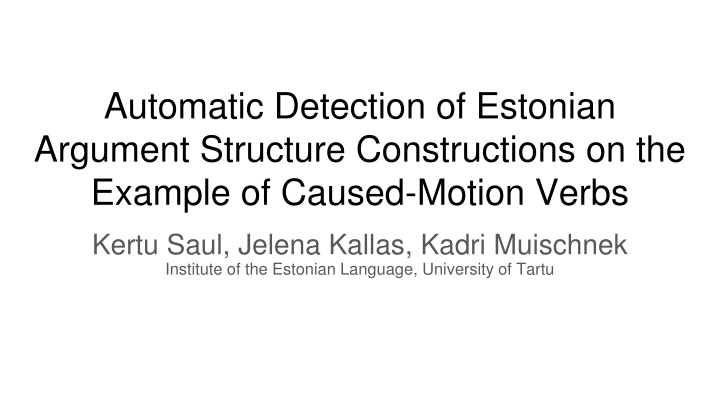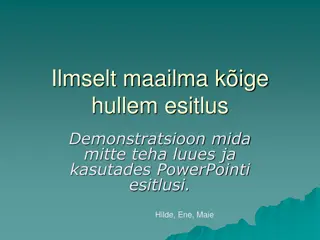
Estonian Argument Structure Constructions Analysis
Explore the automatic detection of Estonian argument structure constructions, focusing on caused-motion verbs. The study delves into the complexity of Estonian free word order, rich nominal cases, and polyfunctional cases, offering solutions for future implementations. Additionally, the research addresses the creation of a preliminary workflow to detect argument structures and the implications for multilingual language technology and language diversity. Discover similar works on detecting constructions and language acquisition models.
Download Presentation

Please find below an Image/Link to download the presentation.
The content on the website is provided AS IS for your information and personal use only. It may not be sold, licensed, or shared on other websites without obtaining consent from the author. If you encounter any issues during the download, it is possible that the publisher has removed the file from their server.
You are allowed to download the files provided on this website for personal or commercial use, subject to the condition that they are used lawfully. All files are the property of their respective owners.
The content on the website is provided AS IS for your information and personal use only. It may not be sold, licensed, or shared on other websites without obtaining consent from the author.
E N D
Presentation Transcript
Automatic Detection of Estonian Argument Structure Constructions on the Example of Caused-Motion Verbs Kertu Saul, Jelena Kallas, Kadri Muischnek Institute of the Estonian Language, University of Tartu
Argument Structure Construction Construction: form-meaning pair Constructions that consist of a verb and its arguments, e.g caused-motion construction nsubj V obj obl+case AGENT VERB PATIENT GOAL Peter threw the ball to Tom. He sneezed the napkin off the table.
About Estonian Free word order Morphologically very rich, 14 nominal cases Arguments can be in most cases Cases are very polyfunctional Lubja-l kadu-s elekter. eile htu-l 80 protsendi-l elanike-l Lubja-ADE disappear-3SG.PST yesterday night-ADE 80 percent-ADE resident.PL-ADE electricity Electricity disappeared for 80 percent of residents in Lubja yesterday night
What we did Create preliminary workflow for automatically detecting argument structures from UD annotated corpora Test it on caused-motion verbs Find primary problems associated with detecting argument structures in Estonian Offer solutions to implement in future work
Why and for whom? WP2 - lexicon-corpus interface PRG1978 - adding constructions to dictionaries manually made lists of argument structures might not reflect actual usage manual compilation too time-consuming and expensive WP3 - multilingual language technology creating a method that s easy to implement for other languages argument structures help improve and develop syntactic and semantic parsers WP4 - language diversity expanding argument structure detection to smaller, non-Indo-European languages
Similar work on detecting constructions Automatic constructicon (Dunn 2023; Forsberg et al 2014) Word forms + POS + semantic clusters/phrase structures Various statistical methods: k-means clustering, Ripple Down Rules algorithm, PMI Problem: only fragments of complete sentences Modelling language acquisition by finding constructions (Doumen et al 2024) Replace differences in similar form-meaning pairs with a slot Problem: requires semantic annotation, simple synthetic input data, only tested on English
Similar work on detecting argument structures Using lexica and clustering (Marchal & Poibeau 2016; Chaminade & Poibeau 2017) Cluster minimal sentences until only one remains for each verb sense Japanese, Finnish Problem: fully lexical, lots of idioms and frozen expressions Using UD: UDLex (Rambelli et al 2017) Find argument structure constructions, which verbs use which frequently, add lexica and Wordnet supersenses to each argument slot Quality: argument structures recall 51-63%, precision 37-55% Problem: only accounts for Indo-European languages (English, French, Italian)
Our method Corpus of 15 million words - science, literature, press. Automatically annotated in UD framework Extract each verb s direct dependents as combinations of syntactic and morphological labels (ie oblique in adessive case) Filter out dependents with syntactic labels that can t be arguments and verb forms that change argument structures Calculate the frequency of each dependent and pair of dependents per verb Filter out dependents and pairs that appear in less than 5% of that verb s sentences Combine remaining pairs into longer argument structures (a+b, a+c, b+c >5% = a+b+c) Only retain each dependent s longest argument structure
Results for 28 caused-motion verbs 107 verb specific argument structures 41 argument structure constructions
Quality Manually compiled argument structures from a UD gold standard corpus Arguments: Recall: 81% Precision: 74% Argument structures: Recall: 34% Precision: 33%
Problems and solutions Polyfunctionality of grammatical units: polyfunctionality makes obliques and adverbials too frequent and heterogeneous Oblique and adverbial dependents should be annotated with their semantic subclass. Verb polysemy: argument structures belonging to a verb s less frequent senses are not found Annotate verbs with meaning, detect argument structures by sense not by verb Arguments can often be elliptic in corpus data and thus not identified Add default subject to non-zero-valent verbs Phraseological verbs are not identified as single lexical units in the source data Integrate lexicons
New argument structures Liigutama move : nsubj obj obl+ine AGENT PATIENT LOCATION Only used when the meaning of the verb is related to feelings Mingi hmane aimdus liiguta-s some vague hunch move-3SG.PST itself.PART Luik-INE Some vague hunch moved itself in Luik. end Luige-s. Pistma put : obj, obl+adit, obl+all PATIENT GOAL RECIPIENT ks de-de-st pist-i-s mu-lle k e one sister-PL-ELA put-PST-3SG I-ALL hand.GEN pants.ADDIT One of the sisters put a hand in my pants. p ksi.
References Rambelli, Giulia, Lenci, Alessandro, & Poibeau, Thierry 2017. UDLex: Towards cross-language subcategorization lexicons. In Fourth International Conference on Dependency Linguistics (Depling 2017). Chaminade, Guersande and Thierry Poibeau 2017. Preliminary Experiments in the Extraction of Predicative Structures from a Large Finnish Corpus. In Proceedings of the Workshop 3rd International Workshop for Computational Linguistics of Uralic Language: 37 55. Marchal, Pierre and Thierry Poibeau 2016. A Continuum-based Model of Lexical Acquisition. In CICLing Conference on Intelligent Text Processing and Computational Linguistics, Konya, Turkey, 2016 Dunn, Jonathan 2023. Exploring the Constructicon: Linguistic Analysis of a Computational CxG. In Proceedings of the First International Workshop on Construction Grammars and NLP (CxGs+NLP, GURT/SyntaxFest 2023), pages 1 11, Washington, D.C.. Association for Computational Linguistics Doumen, Jonas, Katrien Beuls, Paul Van Eecke 2024. Modelling constructivist language acquisition through syntactico-semantic pattern finding, Royal Society Open Science, vol. 11, no. 7, Jul. 2024
















